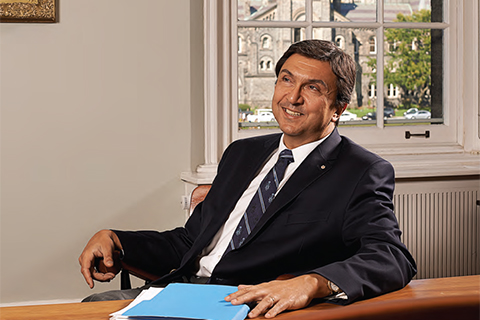Canadians like to think of themselves as one of the best educated populations in the world. A recent report by the Organization for Economic Co-operation and Development (OECD) suggests otherwise. The number of Canadians who earn bachelor’s and graduate degrees is below the OECD average and well behind many other nations. Ample data also suggest that we will lose ground economically unless these gaps are closed.
In response, recession-wracked governments must make some hard choices. More co-ordinated planning, more generous funding and smarter alignment of incentives is needed if we are to accommodate growth in enrolments without eroding the undergraduate student experience in multiple provinces.
This context is part of what led the University of Toronto to undertake the Towards 2030 planning process. Our long-term goal is to rebalance enrolments, improve the undergraduate student experience and capitalize on the unparalleled research strength of the university across all three campuses. It’s a slow slog, largely because the incentives remain strongly and perversely stacked against research-intensive universities.
On that point, I don’t believe that superior research performance means that a particular university is better than others. Stronger research performance, however, does mean that a given university is better suited than others to educating larger numbers of graduate students and may well have advantages in some professional programs. Research universities can also be very propitious places for academically gifted undergraduates. They give young people exposure to some of the finest minds in the country – scholars who share their knowledge in the classroom even as they redefine entire fields.
At the same time, many undergraduates will do as well or better in quite different environments, such as regional comprehensive and undergraduate-focused universities. That’s why major enrolment growth cannot proceed without a rationally diversified system.
There are lessons here from Asia. For example, I have visited top Chinese research-focused institutions such as Peking, Tsinghua and Shanghai Jiao Tong. They are much smaller than most Canadian research universities, and have 50 per cent graduate enrolments. All students live on campus – that’s a requirement. The campuses are large and extremely well equipped. Their student-faculty ratios are also strikingly low, enabling more personalized instruction for the undergraduates who win national competitions to enter these universities.
How did this happen? The Chinese government has explicitly diversified the post-secondary system, positioning 10 universities out of thousands to compete globally in reputation, while supporting a further 90 to be strong national innovators and funding countless other universities to deliver both undergraduate education and selective graduate programming.
We don’t need to emulate the Chinese model, of course, but we can and should learn a few lessons from international trends. Our funding models too often provide incentives for universities to expand undergraduate programs, and penalize them for graduate growth and research intensity. This model is simply not sustainable if Canada is to operate a cost-effective higher-education system and compete in the global knowledge economy.
Last summer, the heads of five institutions that account for a substantial amount of the research and graduate education in Canada had a conversation with Maclean’s magazine and raised these concerns. At first the message was distorted by loud complaints from sister institutions that the “Big Five” were simply seeking to make off with all the research money, or close off the opportunities for other institutions to participate in graduate education. Those misplaced anxieties were stoked by the media, who loved the idea of a food-fight among university leaders.
As the dust settled, however, something interesting happened. It became clear that, while there are some genuine disagreements about how the university system should evolve, the points of convergence are overwhelming. I am struck that many colleagues in leadership roles at universities across Canada are willing to acknowledge that it would be useful to clarify who is supposed to do what, as long as all boats rise, all institutions are respected and supported appropriately, and institutional creativity and entrepreneurship aren’t stifled.
Obviously, that’s a vision that is easier to articulate than achieve. But I sincerely hope we shall make the required efforts to strengthen post-secondary education coast to coast. A diversified and better-balanced university system is absolutely essential if Canada is to succeed in a globally competitive innovation economy. Our future prosperity depends on it.
Adapted in part from a speech to the Canada 2020 group in Ottawa in October 2009. The full text is available here.
Recent Posts
For Greener Buildings, We Need to Rethink How We Construct Them
To meet its pledge to be carbon neutral by 2050, Canada needs to cut emissions from the construction industry. Architecture prof Kelly Doran has ideas
U of T’s 197th Birthday Quiz
Test your knowledge of all things U of T in honour of the university’s 197th anniversary on March 15!
Are Cold Plunges Good for You?
Research suggests they are, in three ways





